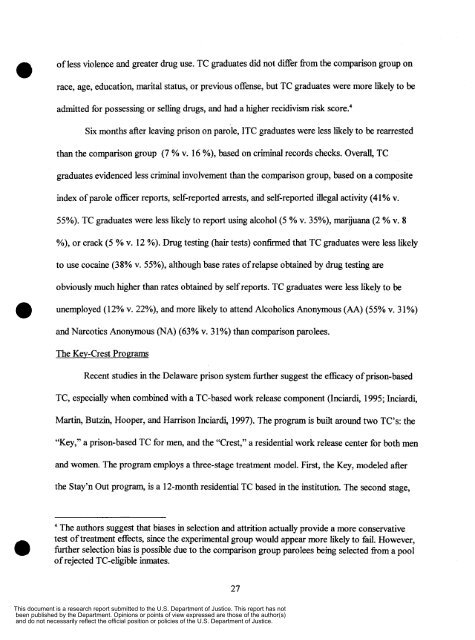0 - National Criminal Justice Reference Service
0 - National Criminal Justice Reference Service
0 - National Criminal Justice Reference Service
Create successful ePaper yourself
Turn your PDF publications into a flip-book with our unique Google optimized e-Paper software.
e<br />
of less violence and greater drug use. TC graduates did not differ from the comparison group on<br />
race, age, education, marital status, or previous offense, but TC graduates were more likely to be<br />
admitted for possessing or selling drugs, and had a higher recidivism risk score.4<br />
Six months after leaving prison on parole, ITC graduates were less likely to be rearrested<br />
than the comparison group (7 % v. 16 %), based on criminal records checks. Overall, TC<br />
graduates evidenced less criminal involvement than the comparison group, based on a composite<br />
index of parole officer reports, self-reported arrests, and self-reported illegal activity (41% v.<br />
55%). TC graduates were less likely to report using alcohol (5 % v. 35%), marijuana (2 % v. 8<br />
%), or crack (5 % v. 12 %). Drug testing (hair tests) confirmed that TC graduates were less likely<br />
to use cocaine (38% v. 55%), although base rates of relapse obtained by drug testing are<br />
obviously much higher than rates obtained by selfreports. TC graduates were less likely to be<br />
unemployed (12% v. 22%), and more likely to attend Alcoholics Anonymous (AA) (55% v. 31%)<br />
and Narcotics Anonymous (NA) (63% v. 31 %) than comparison parolees.<br />
The Key-Crest Programs<br />
Recent studies in the Delaware prison system further suggest the efficacy of prison-based<br />
TC, especially when combined with a TC-based work release component (Inciardi, 1995; Inciardi,<br />
Martin, But& Hooper, and Harrison Inciardi, 1997). The program is built around two TC’s: the<br />
“Key,” a prison-based TC for men, and the “Crest,” a residential work release center for both men<br />
and women. The program employs a three-stage treatment model. First, the Key, modeled after<br />
the Stay’n Out program, is a 12-month residential TC based in the institution. The second stage,<br />
0<br />
The authors suggest that biases in selection and attrition actually provide a more conservative<br />
test of treatment effects, since the experimental group would appear more likely to fail. However,<br />
further selection bias is possible due to the comparison group parolees being selected fiom a pool<br />
of rejected TC-eligible inmates.<br />
27<br />
This document is a research report submitted to the U.S. Department of <strong>Justice</strong>. This report has not<br />
been published by the Department. Opinions or points of view expressed are those of the author(s)<br />
and do not necessarily reflect the official position or policies of the U.S. Department of <strong>Justice</strong>.
















